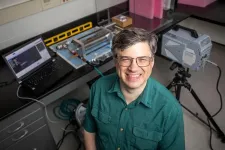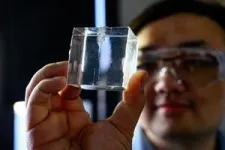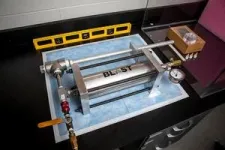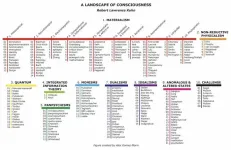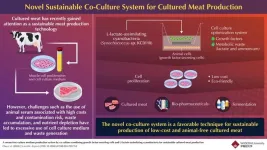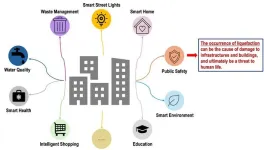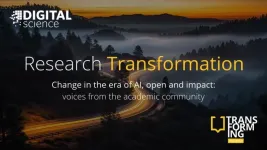(Press-News.org) CHAMPAIGN, Ill. — Thin, stretchy skin — like that of a pig or human — significantly lessens the underlying damage that occurs when it’s punctured. Pig skin even outperforms synthetic materials that are designed to mimic skin, a new study finds. Its special qualities, in particular its ability to dissipate the energy of a puncturing object, greatly reduce the damage to deeper tissues, researchers report.
Their findings appear in the Journal of the Royal Society Interface.
Philip Anderson, a professor of evolution, ecology and behavior who led the study with postdoctoral researcher Bingyang Zhang at the University of Illinois Urbana-Champaign, is fascinated by how the laws of physics influence evolution. This interest led to an exploration of the dynamics of puncturing objects, which are ubiquitous in nature. Watch a video about the new study.
“You’ll find things that puncture across multiple kinds of organisms — vertebrates, invertebrates, plants and fungi — at all scales and different dynamic regimes, so fangs, claws, spines, stingers and other long, sharp implements,” Anderson said.
Isolating all the variables involved in puncture — the speed, shape and sharpness of a puncturing object, for example, or the mechanics of material failure in the target — is a tall task, he said. He and his colleagues started by measuring the basic elements of puncture, using 3D-printed cones with different profiles and sharpness as puncturing objects and silicone gels of various densities as targets. Having answered some fundamental questions about the physics of puncture, Anderson’s lab is now pursuing more in-depth studies of biological materials.
For the new experiments, Zhang tested the “puncturability” of slabs of pork with and without the skin attached and compared the performance of these biological materials with a synthetic mimic: a silicone gel with the approximate rigidity of blubber and another thinner and higher-rigidity gel representing skin. Due to the constraints of the material, the silicone skin was about 4 mm thick, while the animal skin was about 2.5 mm thick. Despite this difference, the team found that real pig skin outperformed the silicone skin in puncture tests that involved shooting a projectile at the materials at different speeds and measuring how deeply they punctured the tissue.
“Using a combination of dynamic puncture experiments and theoretical modeling, we examined the puncture resistance of both natural skin tissues and synthetic bilayer tissue-mimicking materials,” Zhang said. “We found that, despite its thinness, pig skin attached to underlying tissue reduced damage from puncture by about 60% at slower speeds and 73% at higher speeds compared with the same pig tissue without skin.”
Synthetic skin offered less protection, reducing the damage to the underlying gel by less than 40% at slower speeds and less than 30% at higher speeds, the researchers found.
“These findings demonstrate the superior biomechanical performance of natural skin,” Zhang said.
“Having the skin layer is really good at blunting the puncture,” Anderson said. “In fact, at low speeds, the tool couldn’t even puncture the skin.”
The researchers hypothesize that skin’s better performance was due, in part, to the fact that is it made up of collagen fibers, which are woven together and offer resistance even when some of the fibers are broken. The breakage of collagen fibers also dissipates some of the energy of the projectile, slowing it down and lessening its ability to penetrate more deeply into the tissue. Silicone gel lacks this property.
“We have shown the unique ability of natural skin to redistribute force and dissipate energy as a remarkable defensive structure,” Zhang said. “We also learned a great deal about how synthetic materials, while useful in many scenarios, still fall short in replicating these complex biological functions.”
The National Science Foundation supported this work.
Bingyang Zhang is now a postdoctoral researcher at Cornell University.
Editor’s notes:
To reach Philip Anderson, email andersps@illinois.edu.
To reach Bingyang Zhang, email bz364@cornell.edu.
The paper “Being thin-skinned can still reduce damage from dynamic puncture” is available online.
DOI: https://doi.org/10.1098/rsif.2024.0311
END
“Out of meat, how do you get thought? That’s the grandest question.” So said philosopher Patricia Churchland to Robert Lawrence Kuhn, the producer and host of the acclaimed PBS program, Closer to Truth. Now Kuhn, a member of FQxI’s scientific advisory council, has published a taxonomy of proposed solutions to, and theories regarding, the hard problem of consciousness. He produced the organizing framework in order to explore their impact on meaning, purpose and value (if any), AI consciousness, virtual immortality, survival beyond death, and free will. Kuhn's ‘landscape of consciousness’ ...
There are, without a doubt, two broad technological fields that have been developing at an increasingly fast pace over the past decade: artificial intelligence (AI) and the Internet of Things (IoT). By excelling at tasks such as data analysis, image recognition, and natural language processing, AI systems have become undeniably powerful tools in both academic and industry settings. Meanwhile, miniaturization and advances in electronics have made it possible to massively reduce the size of functional devices capable ...
There is a pressing need for environmentally friendly meat production technologies to tackle the increasing global food demand. Cultured meat production is one such technology that is attracting a lot of attention as an alternative to conventional meat production. First developed in 2012, cultured meat is simply meat that is produced by growing or culturing muscle cells from animals in a laboratory.
Typically, cultured meat production requires serum (or the liquid part of the blood) from animals, which is essential for the growth of muscle cells in the culture medium since serum includes abundant proteins that promote muscle cell growth. ...
Recent advances in three-dimensional (3D) scanning, particularly in photogrammetry and laser scanning, have made it possible to quickly and accurately scan complex 3D objects in the real world. These techniques generate detailed models by collecting large-scale point cloud data, representing the object's surface geometry through millions of individual points. This technology has applications in different fields, such as the 3D scanning of cultural heritage objects. By preserving these objects in digital formats, ...
As urban areas expand, the threat of natural disasters becomes a pressing concern for city planners and disaster management authorities. In earthquake-prone countries like Japan, one of the critical risks to infrastructure is liquefaction, a phenomenon where intense shaking causes loose, water-saturated soils to lose their strength and behave like a liquid. Liquefaction can cause buildings to sink into the soil, crack foundations, and collapse roads and utilities like water lines.
Soil liquefaction accompanies every major earthquake, and the damage is significant. The 2011 Tōhoku earthquake in Japan caused liquefaction ...
Metal peroxide (MO2, M=Ca, Sr, Ba) is an alternative to hydrogen peroxide (H2O2). It has excellent oxidative properties, superior chemical stability, high purity, and is easy to store and transport. It has been widely used in wastewater treatment and disinfection.
A Chinese research group has recently developed a novel self-cleaning electrode by constructing a micro-/nanostructure of a highly active catalyst with appropriate surface modification, achieving highly stable synthesis of alkaline-earth MO2.
This study was published in Nature Nanotechnology.
The current primary synthesis process of MO2 involves fast decomposition of H2O2, leading to insufficient utilization ...
Digital Science, a technology company serving stakeholders across the research ecosystem, is today calling for greater awareness of the impact that a myriad of fast-developing technologies are having on academics and their institutions.
This follows the publication of a new report from Digital Science looking at how changing attitudes and behaviors towards research are affecting traditional research models and dynamics. Key themes to emerge from the findings relate to areas of open research, impact and evaluation, tech and AI, collaboration and research security.
The objective of the report – titled Research Transformation: Change in the era of AI, open and impact ...
Researchers from the University of Oxford have identified a key biochemical mechanism relevant to the development of Huntington’s Disease. This discovery opens up the possibility of studying the disease before its clinical onset and eventually stopping its progression.
The study, published in Nature Metabolism, has shown for the first time the biochemical change responsible for the development of Huntington’s disease, and how blocking this change stopped disease progression.
Huntington's disease is an inherited condition that stops parts of the brain from working properly, leading to mental and physical decline that slowly ...
The potential of human-AI collaboration has captured our imagination: a future where human creativity and AI's analytical power combine to make critical decisions and solve complex problems. But new research from the MIT Center for Collective Intelligence (CCI) suggests this vision may be much more nuanced than we once thought.
Published today in Nature Human Behaviour, “When Combinations of Humans and AI Are Useful” is the first large-scale meta-analysis conducted to better understand when human-AI combinations are useful in task completion, and when they are not. Surprisingly, the research has found that combining humans and AI to ...
Researchers at UCLA Health have found that a person's risk of developing psychotic-like experiences may be influenced by both childhood attention problems and their genetic makeup.
The findings, published in Nature Mental Health, build upon a long-studied association between childhood attention problems and the likelihood of later developing schizophrenia. Using data from about 10,000 children over six years, UCLA researchers led by Dr. Carrie Bearden sought to determine how attentional variability ...
